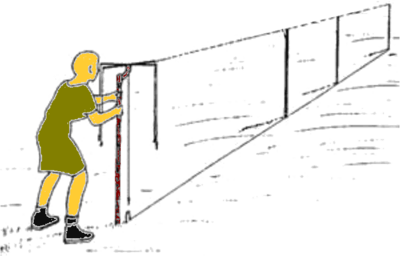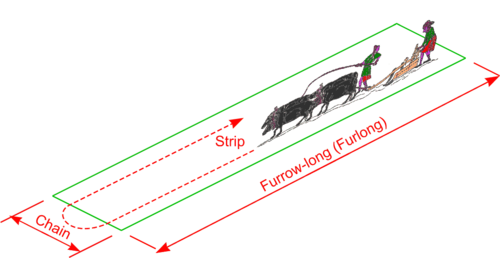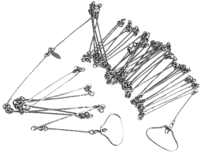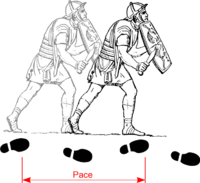Early Surveying: Difference between revisions
From DT Online
No edit summary |
mNo edit summary |
||
| (One intermediate revision by the same user not shown) | |||
| Line 35: | Line 35: | ||
---- | ---- | ||
<span style="color: blue">'''Activity:'''</span> | <span style="color: blue">'''Activity:'''</span> | ||
* <span style="color: blue">Select and mark a starting point in an open space such as a playing field. Count 10 of your own '''Paces''' and mark where you get to. Use a measuring tape to find | * <span style="color: blue">Select and mark a starting point in an open space such as a playing field. Count 10 of your own '''Paces''' and mark where you get to. Use a measuring tape to find out how far you have travelled.</span> | ||
** <span style="color: blue">How far would you have travelled after 1000 '''Paces'''?</span> | ** <span style="color: blue">How far would you have travelled after 1000 '''Paces'''?</span> | ||
** <span style="color: blue">How many '''Paces''' would you have to complete to travel an old '''Mile''' as [https://en.wikipedia.org/wiki/Centurion|'''Roman Centurions'''] once did?</span> | ** <span style="color: blue">How many '''Paces''' would you have to complete to travel an old '''Mile''' as [https://en.wikipedia.org/wiki/Centurion|'''Roman Centurions'''] once did?</span> | ||
| Line 42: | Line 42: | ||
[[Category:Primary]] | [[Category:Primary]] | ||
[[Category:Topics, Projects and Tasks]] | |||
[[Category:Topics]] | [[Category:Topics]] | ||
[[Category:Measuring and Surveying]] | [[Category:Measuring and Surveying]] | ||
Latest revision as of 14:50, 15 March 2021
It is believed that Stone Henge would have been set out using ropes and pegs and so Surveying can be thought of as a very ancient craft. Certainly Surveying was very important in Ancient Egypt both to establish land ownership and to mark out the Pyramids for example.
In Medieval England the land was owned by the Lord of the Manor and allocated to families for farming in the form of Strips. Each strip was the length a team of oxen could pull a plough before needing to rest and their width was the distance needed to turn the oxen and plough around to plough in the return direction. [DT Online: rather than returning alongside the previous furrow, it seems possible that two adjacent Strips may have been ploughed together - up one Strip and down the other a Strip width away.]
This process led to the establishment of agreed land measurements probably based on the Roman Perch or Rod since this was so well established by then it was impractical to change it.
A Rod, Pole or Perch is a length measurement (about 5 metres) which was used in land measurement during the Middle Ages but no longer in widespread use. It is possible that the name comes from the need for a Ploughman to have a long stick with which to control oxen but it is also a similar size to military [1] or Weapons used both by the Romans and during the Middle Ages.
Medieval Strips for farming were 4 Rods wide which gave the Oxen enough space to turn round and start the next Furrow without travelling an unnecessary distance. This measurement became known as a Chain and was established as a unit of length equal to 66 feet (22 yards). [DT Online: Perhaps there was some association with the length of plough chains?]
In 1620, Edmund Gunter developed an actual measuring chain of 100 links, with brass marker tags every 10 links, and early surveyors used this metal chain, laid out with the help of a compass, to draw plans of areas of land. Although no longer in common use, cricket pitches are still a Chain (22 yards) long and the distances along a railway are still known as Chainage – although now measured in metres.
This railway distance marker is found under a bridge at Feltham railway station for example. RDG1 is the Engineer's Line Reference (ELR) identifying the railway line from Waterloo to Wokingham Junction and gives the distance from Waterloo in Miles and Chains. Each distance marker is unique so any location on the railway network can be found using a combination of ELR and mileage.
A farming strip of land was set to the length of a plough furrow at 10 Chains (220 yards). Strips were a furrow-long or Furlong, which is a term still used in horse racing today. Each strip was therefore a furrow-long and a Chain wide giving it an area of 220 yards x 22 yards which is the measure of an Acre (4840 square yards) – ie about half the size of a football pitch. In the UK, the use of the Acre as the primary unit for land registration was officially replaced by the Hectare on 1 January 2010.
The word Mile comes from the Latin mille, meaning thousand, and a mile was 1,000 Roman Paces as measured by every other step - i.e. the total distance of the left foot hitting the ground 1,000 times. It is thought that, as the Romans explored new lands, the marching armies would often push a carved stick in the ground after each 1,000 Paces. At about the year 1500 the Old London Mile was defined as eight Furlongs (furlong = 660 feet). A Mile is equal to 5,280 Feet or 1,760 Yards or approximately 1,609 Meters.
Activity:
- Select and mark a starting point in an open space such as a playing field. Count 10 of your own Paces and mark where you get to. Use a measuring tape to find out how far you have travelled.
- How far would you have travelled after 1000 Paces?
- How many Paces would you have to complete to travel an old Mile as Roman Centurions once did?





